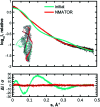ATSAS 3.0: expanded functionality and new tools for small-angle scattering data analysis
- PMID: 33833657
- PMCID: PMC7941305
- DOI: 10.1107/S1600576720013412
ATSAS 3.0: expanded functionality and new tools for small-angle scattering data analysis
Abstract
The ATSAS software suite encompasses a number of programs for the processing, visualization, analysis and modelling of small-angle scattering data, with a focus on the data measured from biological macromolecules. Here, new developments in the ATSAS 3.0 package are described. They include IMSIM, for simulating isotropic 2D scattering patterns; IMOP, to perform operations on 2D images and masks; DATRESAMPLE, a method for variance estimation of structural invariants through parametric resampling; DATFT, which computes the pair distance distribution function by a direct Fourier transform of the scattering data; PDDFFIT, to compute the scattering data from a pair distance distribution function, allowing comparison with the experimental data; a new module in DATMW for Bayesian consensus-based concentration-independent molecular weight estimation; DATMIF, an ab initio shape analysis method that optimizes the search model directly against the scattering data; DAMEMB, an application to set up the initial search volume for multiphase modelling of membrane proteins; ELLLIP, to perform quasi-atomistic modelling of liposomes with elliptical shapes; NMATOR, which models conformational changes in nucleic acid structures through normal mode analysis in torsion angle space; DAMMIX, which reconstructs the shape of an unknown intermediate in an evolving system; and LIPMIX and BILMIX, for modelling multilamellar and asymmetric lipid vesicles, respectively. In addition, technical updates were deployed to facilitate maintainability of the package, which include porting the PRIMUS graphical interface to Qt5, updating SASpy - a PyMOL plugin to run a subset of ATSAS tools - to be both Python 2 and 3 compatible, and adding utilities to facilitate mmCIF compatibility in future ATSAS releases. All these features are implemented in ATSAS 3.0, freely available for academic users at https://www.embl-hamburg.de/biosaxs/software.html.
Keywords: ATSAS; biological macromolecules; data analysis; small-angle scattering; structural modelling.
© Karen Manalastas-Cantos et al. 2021.
Figures










Similar articles
-
ATSAS 2.8: a comprehensive data analysis suite for small-angle scattering from macromolecular solutions.J Appl Crystallogr. 2017 Jun 26;50(Pt 4):1212-1225. doi: 10.1107/S1600576717007786. eCollection 2017 Aug 1. J Appl Crystallogr. 2017. PMID: 28808438 Free PMC article.
-
Computational methods for the analysis of solution small-angle X-ray scattering of biomolecules: ATSAS.Methods Enzymol. 2023;678:193-236. doi: 10.1016/bs.mie.2022.09.019. Epub 2022 Oct 31. Methods Enzymol. 2023. PMID: 36641208 Review.
-
New features in ATSAS-4, a program suite for small-angle scattering data analysis.J Appl Crystallogr. 2025 Apr 15;58(Pt 3):1027-1033. doi: 10.1107/S1600576725002481. eCollection 2025 Jun 1. J Appl Crystallogr. 2025. PMID: 40475945 Free PMC article.
-
SASpy: a PyMOL plugin for manipulation and refinement of hybrid models against small angle X-ray scattering data.Bioinformatics. 2016 Jul 1;32(13):2062-4. doi: 10.1093/bioinformatics/btw071. Epub 2016 Feb 28. Bioinformatics. 2016. PMID: 27153695 Free PMC article.
-
PDBx/mmCIF Ecosystem: Foundational Semantic Tools for Structural Biology.J Mol Biol. 2022 Jun 15;434(11):167599. doi: 10.1016/j.jmb.2022.167599. Epub 2022 Apr 20. J Mol Biol. 2022. PMID: 35460671 Free PMC article. Review.
Cited by
-
Deciphering the allosteric regulation of mycobacterial inosine-5'-monophosphate dehydrogenase.Nat Commun. 2024 Aug 6;15(1):6673. doi: 10.1038/s41467-024-50933-6. Nat Commun. 2024. PMID: 39107302 Free PMC article.
-
Correlating Conformational Equilibria with Catalysis in the Electron Bifurcating EtfABCX of Thermotoga maritima.Biochemistry. 2024 Jan 2;63(1):128-140. doi: 10.1021/acs.biochem.3c00472. Epub 2023 Nov 27. Biochemistry. 2024. PMID: 38013433 Free PMC article.
-
Hemoglobin-PEG Interactions Probed by Small-Angle X-ray Scattering: Insights for Crystallization and Diagnostics Applications.J Phys Chem B. 2024 Sep 26;128(38):9262-9273. doi: 10.1021/acs.jpcb.4c03003. Epub 2024 Sep 9. J Phys Chem B. 2024. PMID: 39252421 Free PMC article.
-
Solution structure, dynamics and tetrahedral assembly of Anti-TRAP, a homo-trimeric triskelion-shaped regulator of tryptophan biosynthesis in Bacillus subtilis.J Struct Biol X. 2024 Jun 11;10:100103. doi: 10.1016/j.yjsbx.2024.100103. eCollection 2024 Dec. J Struct Biol X. 2024. PMID: 39035014 Free PMC article.
-
7-Deazaguanines in DNA: functional and structural elucidation of a DNA modification system.Nucleic Acids Res. 2023 May 8;51(8):3836-3854. doi: 10.1093/nar/gkad141. Nucleic Acids Res. 2023. PMID: 36928176 Free PMC article.
References
-
- Adams, P. D., Afonine, P. V., Baskaran, K., Berman, H. M., Berrisford, J., Bricogne, G., Brown, D. G., Burley, S. K., Chen, M., Feng, Z., Flensburg, C., Gutmanas, A., Hoch, J. C., Ikegawa, Y., Kengaku, Y., Krissinel, E., Kurisu, G., Liang, Y., Liebschner, D., Mak, L., Markley, J. L., Moriarty, N. W., Murshudov, G. N., Noble, M., Peisach, E., Persikova, I., Poon, B. K., Sobolev, O. V., Ulrich, E. L., Velankar, S., Vonrhein, C., Westbrook, J., Wojdyr, M., Yokochi, M. & Young, J. Y. (2019). Acta Cryst. D75, 451–454. - PMC - PubMed
-
- Anderson, T. W. & Darling, D. A. (1954). J. Am. Stat. Assoc. 49, 765–769.
-
- Anscombe, F. J. (1948). Biometrika, 35, 246–254.
LinkOut - more resources
Full Text Sources
Other Literature Sources
